Introduction: The AI Revolution is Here
Let’s be honest – AI isn’t just a buzzword anymore. We’ve gone from asking ChatGPT silly questions to watching entire customer service departments get revolutionized by AI chatbots. Companies like Domino’s are using AI to predict when you’ll want pizza (scary accurate, by the way), and Netflix knows what you want to watch before you do.
Here’s the thing: if you’re still thinking “AI is just for tech companies,” you’re already behind. Your customers are getting spoiled by AI-powered experiences everywhere else, and they’re starting to expect the same level of service from your business.
So what does “future-proofing” actually mean? Think of it like this – you’re not just buying a fancy new tool and calling it a day. You’re building a business that can adapt and grow with AI technology, kind of like how smartphones evolved from basic calling devices to the mini-computers we can’t live without today.
Don’t worry if this sounds overwhelming. Whether you’re running a local bakery or managing a mid-size manufacturing company, this guide will show you exactly how to get started with AI in 2025 – no computer science degree required.
Understanding the Current AI Landscape
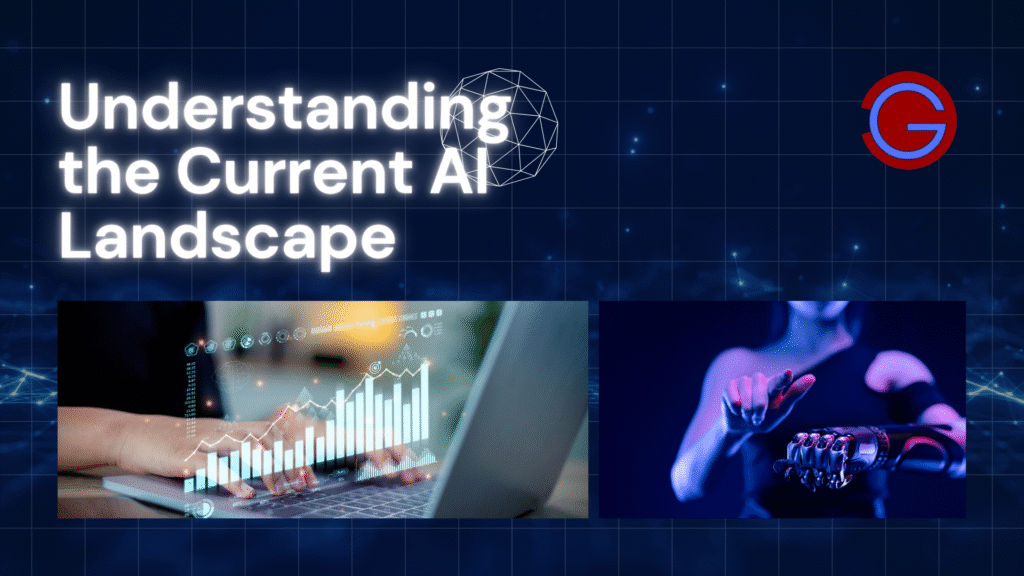
Remember when having a website was optional? Well, AI is following the same path, except much faster.
Take customer service, for example. Sephora’s chatbot can help you find the perfect lipstick shade by analyzing a photo of your outfit. Airbnb uses AI to automatically generate property descriptions that actually sound appealing. And companies like Spotify create personalized playlists so good that you forget you didn’t make them yourself.
The best part? You don’t need a million-dollar budget to get started. Tools like Zapier’s AI features can automate your workflows for less than $50 a month. Canva’s AI can create professional-looking graphics in seconds. Even small accounting firms are using AI to automatically categorize expenses and flag potential issues.
Here’s what changed: AI used to require a team of data scientists and months of development. Now you can sign up for an AI tool and start using it this afternoon. It’s like the difference between building your own car and simply getting a driver’s license.
Identifying AI Opportunities in Your Business
Let’s get practical. Grab a coffee and think about your typical workday. What tasks make you think, “There has to be a better way to do this”?
Start with an honest look at your business:
- Are you spending hours manually entering data that could be automated?
- Do customers ask the same questions over and over?
- Are you struggling to keep up with social media posting?
- Do you wish you could predict which products will sell best next month?
Map out your daily frustrations: Sarah, who runs a small marketing agency, realized she was spending 10 hours a week writing client reports. Now she uses AI to generate first drafts in 30 minutes, then spends her time adding strategic insights that actually matter.
Look at your customer interactions: A local restaurant owner noticed customers kept calling to ask about daily specials. Instead of hiring more staff, he set up an AI chatbot on his website that answers these questions instantly and even takes reservations.
Check out your data goldmine: You probably have more valuable data than you realize. Your sales history, customer emails, and website analytics are like ingredients for AI recipes. A small online retailer discovered that customers who bought certain items together were 3x more likely to become repeat buyers – information they used to create targeted email campaigns.
Strategic AI Implementation Framework
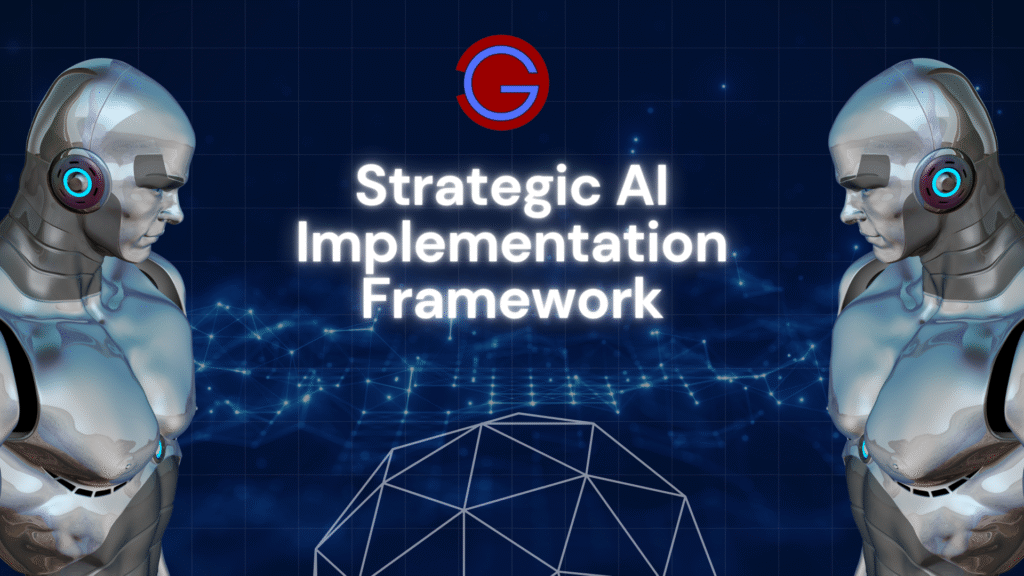
Here’s the secret: don’t try to become Google overnight. Start small and build momentum.
The “Training Wheels” Approach: Pick one annoying task and solve it with AI first. Maybe it’s scheduling social media posts, generating product descriptions, or creating email subject lines. Once you see how much time you save, you’ll get excited about bigger possibilities.
Build vs. Buy – The Coffee Shop Analogy: You wouldn’t build your own espresso machine before learning to make coffee, right? Same with AI. Start with existing tools like ChatGPT for content, Calendly for scheduling, or HubSpot for customer management. Save custom AI development for when you’re ready to scale.
Create your AI dream team: You don’t need to hire a Chief AI Officer. Start with a small group of curious employees from different departments. Maybe your marketing person who loves trying new tools, your IT person who gets excited about automation, and your customer service manager who knows exactly what customers need.
Define what success looks like: Instead of vague goals like “improve efficiency,” get specific. “Reduce customer response time from 4 hours to 30 minutes” or “increase email open rates by 15%” – numbers you can actually measure and celebrate.
Essential AI Applications for Business Growth
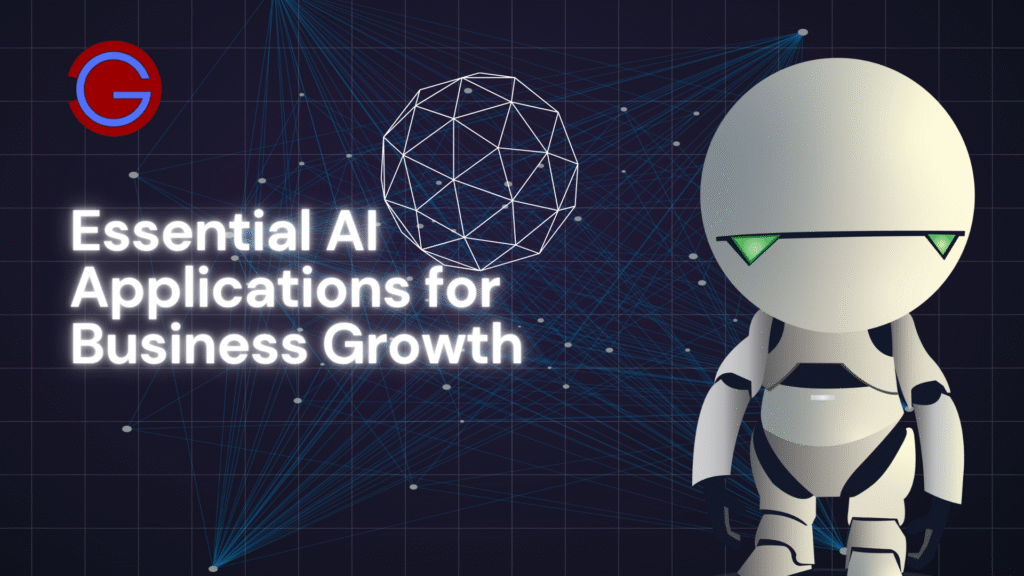
Let’s talk about the AI tools that can make an immediate difference in your business.
Customer Service That Never Sleeps: Imagine having a customer service rep who never takes a sick day, never has a bad mood, and can handle 50 conversations simultaneously. That’s what AI chatbots like Intercom or Zendesk’s Answer Bot can do. They handle the routine stuff – order status, return policies, store hours – so your human team can focus on complex problems that need a personal touch.
Crystal Ball for Your Business: Predictive analytics sounds fancy, but it’s really just AI looking at your past data to predict the future. A small clothing boutique uses AI to predict which styles will be popular next season based on social media trends and past sales. A local gym uses it to predict which members might cancel their memberships so they can offer incentives to stay.
Personal Shopper for Every Customer: Amazon’s “People who bought this also bought” feature isn’t magic – it’s AI. Tools like Dynamic Yield or even Shopify’s built-in recommendations can do this for your business too. It’s like having a personal shopper who knows exactly what each customer likes.
The Invisible Assistant: Process automation is like having an invisible employee who never makes mistakes. Zapier can automatically add new customers to your email list, create invoices in your accounting software, and even post customer photos to your social media (with permission, of course).
Your Data Detective: AI can spot patterns in your data that humans might miss. A local restaurant discovered that customers who ordered appetizers were 60% more likely to leave positive reviews. Now they train servers to recommend appetizers, and their ratings have improved significantly.
Overcoming Common AI Implementation Challenges
Let’s address the elephant in the room – the fears and roadblocks that might be holding you back.
“Will AI Replace My Employees?” Short answer: probably not. AI is more like a really good intern – it can handle the boring, repetitive stuff so your team can focus on creative problem-solving and building relationships. A local accounting firm uses AI to categorize transactions automatically, which freed up their bookkeeper to spend more time advising clients on tax strategies.
“What About Data Privacy?” This is serious, but not insurmountable. Think of it like installing a security system – you need to be careful about who has access to what. Use reputable AI vendors who are transparent about their data practices. Tools like Microsoft’s AI services and Google’s Cloud AI are designed with enterprise-level security in mind.
“Our Systems Are Ancient” You don’t need to overhaul everything at once. Many AI tools work alongside existing systems. A manufacturing company kept their old inventory system but added an AI layer that predicts when to reorder parts. The AI pulls data from the old system but doesn’t replace it.
“We Don’t Have AI Experts” Neither did most successful AI adopters when they started. The key is learning as you go. Start with user-friendly tools that don’t require coding. YouTube has thousands of tutorials, and many AI companies offer free training to get you started.
Building an AI-Ready Organizational Culture
This is where the magic happens – getting your team excited about AI instead of scared of it.
Lead by Example: If you’re the business owner or manager, start using AI tools yourself. Share your wins (and fails) with your team. When your employees see you experimenting with AI to write better emails or create presentations, they’ll be more open to trying it themselves.
Make It Fun: Turn AI experimentation into a game. Challenge your team to find new ways to use AI tools. One marketing agency has “AI Fridays” where team members share cool AI discoveries over lunch. The winner gets to pick the next team lunch spot.
Invest in Learning: Set aside budget for AI training, even if it’s just $50/month for online courses. Platforms like Coursera, LinkedIn Learning, and YouTube have excellent AI courses for beginners. Some employees might discover they love working with AI and become your internal champions.
Partner with Experts: You don’t need to figure everything out alone. Many AI vendors offer free consultations. Local business groups often have members who’ve successfully implemented AI. Don’t be afraid to ask for help – most people love sharing their success stories.
Preparing for Future AI Developments
The AI landscape changes fast, but you can stay ahead by being smart about how you build your foundation.
Stay Connected: Follow a few AI newsletters or blogs. “The Batch” by Andrew Ng is great for beginners. Set up Google Alerts for “AI in [your industry]” to catch relevant developments. Spend 15 minutes a week reading about AI trends – it’s like staying current with any other business trend.
Build Smart Infrastructure: Choose cloud-based tools when possible. They update automatically and can scale with your business. Avoid getting locked into one vendor’s ecosystem. It’s like choosing a phone plan – you want flexibility to switch if something better comes along.
Create Innovation Time: Give your team permission to experiment. Google’s famous “20% time” policy led to Gmail and Google Maps. Maybe your employees can spend one hour a week exploring new AI tools. You never know what breakthrough they might discover.
Industry-Specific AI Applications
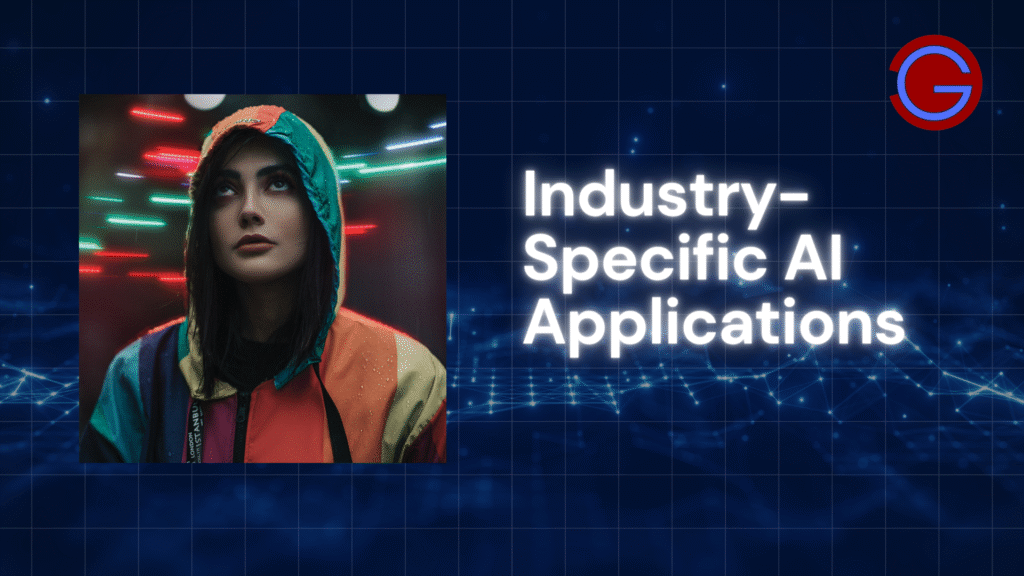
Let’s get specific about how AI can help different types of businesses.
Retail & E-commerce: A small jewelry store uses AI to automatically write product descriptions and adjust prices based on competitor analysis. A local bookstore uses AI to recommend books based on customers’ previous purchases and reading preferences, increasing sales by 25%.
Healthcare: A dental practice uses AI to schedule appointments and send reminder texts, reducing no-shows by 40%. A physical therapy clinic uses AI to analyze patient movement patterns and suggest personalized exercise plans.
Finance: A small accounting firm uses AI to detect unusual transactions that might indicate fraud or errors. A local credit union uses AI chatbots to answer common questions about loan applications and account balances.
Manufacturing: A small furniture manufacturer uses AI to predict when machines need maintenance, preventing costly breakdowns. A local food producer uses AI to optimize production schedules based on demand forecasts.
Professional Services: A law firm uses AI to quickly search through case documents and find relevant precedents. A consulting company uses AI to analyze client data and generate initial reports, freeing up consultants to focus on strategic recommendations.
Measuring Success and ROI
Numbers don’t lie, and they’ll help you make the case for more AI investment.
Track the Right Metrics: Don’t just measure “AI usage” – measure business impact. A local restaurant tracked how their AI-powered ordering system reduced wait times by 30% and increased customer satisfaction scores. A small marketing agency measured how AI-generated content drafts reduced project timelines by 50%.
Think Short-term and Long-term: Week 1: Your AI chatbot might handle 20% of customer inquiries. Month 3: It’s handling 60% and your team is happier. Year 1: Customer satisfaction is up 25% and you’ve saved enough on support costs to hire a new salesperson.
Calculate Real Savings: If AI saves each employee 2 hours per week, and you have 10 employees earning $25/hour, that’s $500/week in savings. Over a year, that’s $26,000 – enough to pay for a lot of AI tools and training.
Compare to Competitors: Are you responding to customer inquiries faster than your competitors? Are your prices more competitive because AI helps you operate more efficiently? These advantages compound over time.
Future-Proofing Strategies for Long-Term Success
Think of this as building a house – you want a strong foundation that can support future additions.
Stay Flexible: Choose AI tools that play well with others. Avoid platforms that lock you in with proprietary formats. It’s like choosing furniture that can move with you to a new house.
Keep Learning: AI is evolving rapidly. What’s cutting-edge today might be basic tomorrow. Encourage your team to stay curious and keep experimenting. The businesses that succeed with AI are the ones that treat it as an ongoing journey, not a one-time destination.
Build Your AI Center of Excellence: This sounds fancy, but it can be as simple as designating one person as your “AI champion” who stays up-to-date on new tools and trains others. As you grow, this person can help evaluate new AI opportunities and ensure you’re getting the most from your investments.
Plan for Scale: Choose solutions that can grow with your business. That AI chatbot that handles 100 conversations per month should be able to handle 1,000 as your business expands. Think ahead about how your AI needs might evolve.
Conclusion: Taking Action in 2025
Here’s the bottom line: AI isn’t going away, and neither is the competitive advantage it provides. The businesses thriving in 2025 aren’t necessarily the ones with the biggest budgets – they’re the ones that started experimenting, learning, and adapting.
You don’t need to become an AI expert overnight. Start with one small project. Maybe it’s using AI to write better email subject lines, or setting up a simple chatbot to answer common questions. The key is to start.
Remember, every AI success story started with someone who was exactly where you are now – curious but maybe a little overwhelmed, excited about the possibilities but unsure where to begin.
Your Next Steps:
- Pick one repetitive task in your business with Voice Flow that annoys you
- Research AI search engine tools that could help with that task
- Try a free trial or low-cost option
- Measure the results
- Share your success with your team
- Repeat with a bigger challenge
The future belongs to businesses that embrace AI not as a replacement for human creativity and judgment, but as a powerful tool that amplifies what humans do best. The question isn’t whether you can afford to invest in AI – it’s whether you can afford not to.
Ready to get started? The best time to plant a tree was 20 years ago. The second-best time is today. Your AI journey starts now.

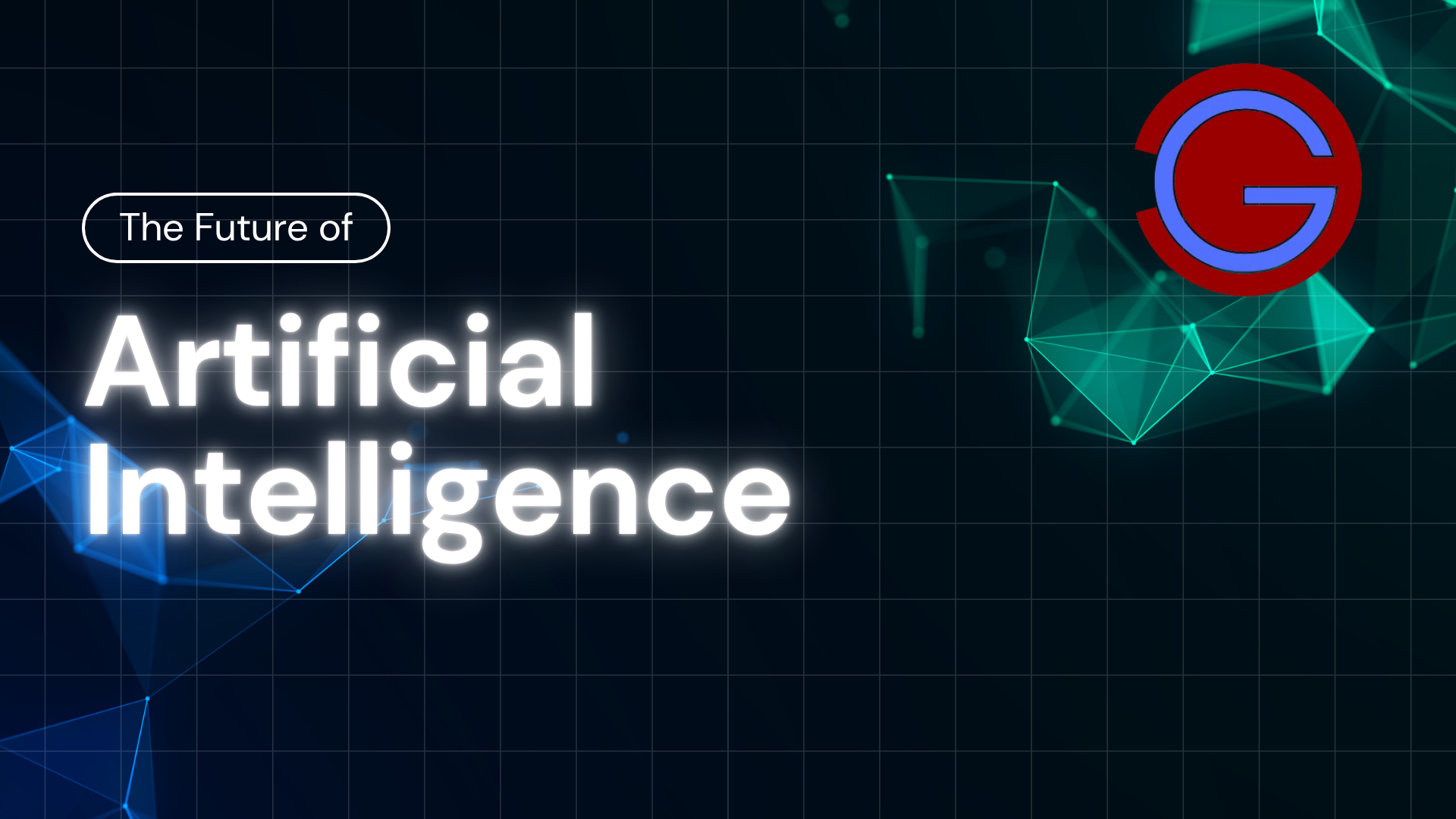

2 thoughts on “How to Future-Proof Your Business with AI in 2025”